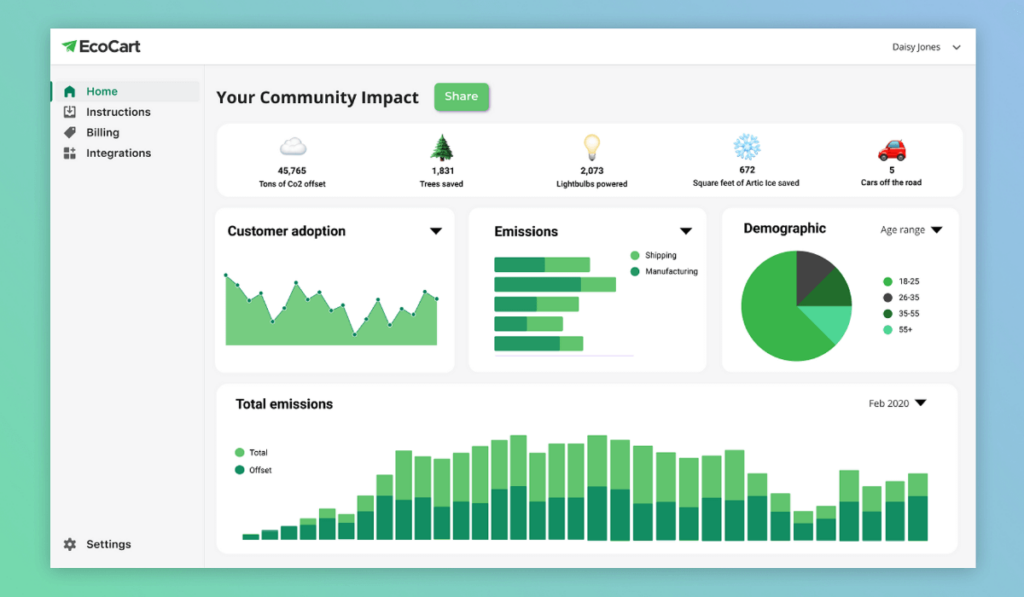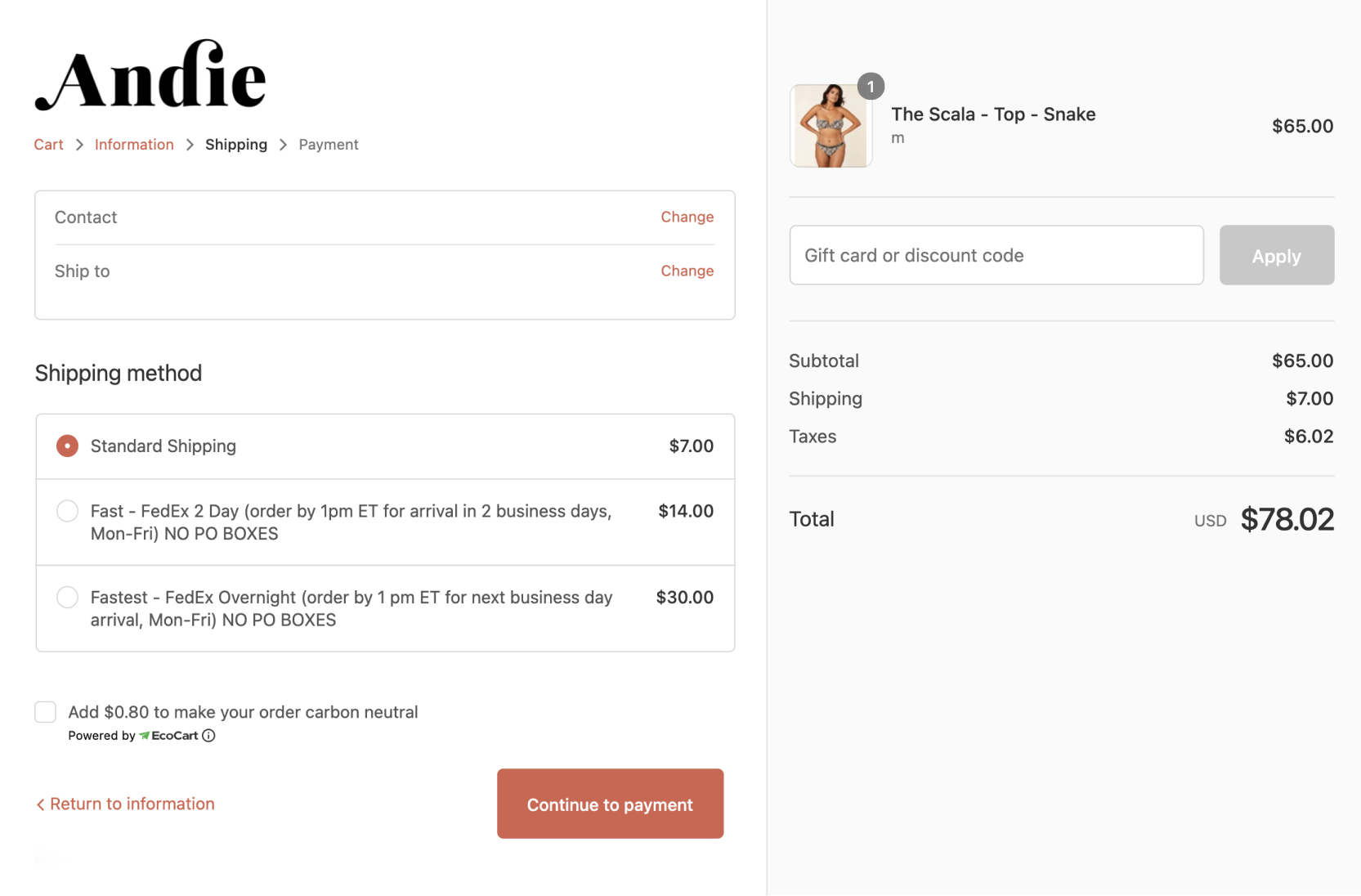In the discourse surrounding climate action, the concept of “climate positivity” has emerged as a beacon of hope. However, the path to genuine climate positivity is fraught with challenges, particularly concerning the reliance on carbon neutrality claims that hinge solely on offsetting schemes. This approach has increasingly come under scrutiny, drawing criticism for contributing to a phenomenon nearly indistinguishable from greenwashing.
In this article, we’ll discuss what climate positive means, why it’s a problematic term in ecommerce, and how businesses can reduce and mitigate greenhouse gas emissions in an ethical and impactful way.
What Does “Climate Positive” Mean?
“Climate positive” means taking actions that remove more greenhouse gasses from the atmosphere than one’s activities emit, resulting in a net positive impact on the environment.
The Problem With “Climate Positivity”
The crux of the issue lies in the practice of offsetting emissions without a concurrent strategy for actual reductions. Such practices are derided as merely “paying to pollute,” a method fundamentally misaligned with the rigorous demands of climate science, which emphasizes the necessity of limiting the most severe impacts of climate change. Moreover, the Voluntary Carbon Market (VCM) faces ongoing credibility issues, further complicating the landscape.
The regulatory environment is rapidly evolving in response to these concerns. Notably, the European Union has taken a firm stance, announcing that by 2026, unsubstantiated claims of carbon neutrality and net zero will be prohibited. This regulation mandates that any claim of carbon neutrality must be backed by a tangible and active emissions reduction strategy. It is anticipated that the United States will implement similar regulations in the near future, reflecting a growing consensus on the need for authenticity and accountability in climate commitments.

The rise in climate litigation underscores the seriousness with which these misleading claims are being addressed. A significant number of legal challenges are already underway, targeting companies that assert carbon neutrality based solely on carbon offsets. These cases highlight the legal risks associated with making unfounded environmental claims and signal a broader shift towards greater scrutiny and accountability.
In this context, the safest harbor for companies and organizations is a commitment to transparency and the use of intentional language. Rather than making definitive claims, it is advisable to communicate sustainability goals and intentions clearly, thereby avoiding the pitfalls of greenwashing and the increasing likelihood of climate litigation. This approach not only aligns with regulatory trends but also resonates with a growing public demand for genuine, impactful climate action.
Climate Positive vs Net Zero
In the evolving dialogue on climate action, several key terms have emerged, each signifying different levels of commitment and impact on carbon emissions. Understanding the nuances between these terms is crucial for companies aiming to align their environmental strategies with global sustainability goals.
Here’s a clearer explanation of the differences and why the focus should increasingly shift towards achieving “net zero emissions.”
- Climate positive: When activities go beyond net zero to actually remove carbon from the atmosphere, resulting in negative carbon emissions. This is problematic because it does not actually indicate that a business has reduced emissions, but instead has simply paid to offset its greenhouse gas emissions.
- Carbon neutral: When activities either release no carbon emissions into the atmosphere or emissions are mitigated, and therefore “neutralized”, through carbon offset projects. This does not actually imply that a business has made any efforts to reduce carbon emissions in its operations.
- Net zero: The Net-Zero Standard states that at least 90% of carbon emissions must be eliminated from operations, while the remaining 10% or less can be offset. This standard ensures that companies prioritize actual emission reductions in their operations, making net zero a more robust and meaningful commitment to climate action.
Companies working toward net zero carbon emissions through both reduction and mitigation are true champions of climate change.
The Importance Of Reducing And Mitigating Emissions For Ecommerce Businesses
According to McKinsey, the United States emits 7.2 billion tonnes of carbon each year, spanning every sector. This means that every business is culpable for their carbon footprints; companies big and small should take steps to become carbon neutral to enact the change needed to stop climate change.
Besides environmental factors, consumers seek sustainability when making purchasing decisions. In fact, a study by McKinsey and NielsenIQ found that “Products making ESG-related claims averaged 28 percent cumulative growth over the past five-year period, versus 20 percent for products that made no such claims.”
See this case study for a real life example: Simbly’s Focus on Sustainability Helps Average Order Value Skyrocket 38%
At the bare minimum, companies should aim for carbon neutrality in order to compete in the modern market. Businesses that pursue positive climate strategies, such as reducing emissions and offsetting emissions that cannot immediately be reduced, place themselves ahead of the competition, getting on top of consumer desires.
The Benefits And Challenges Of Adopting A Net Zero Strategy
Adopting a net zero strategy presents a unique set of benefits and challenges for ecommerce business owners. As the digital marketplace continues to grow, so does the responsibility of these businesses to address their environmental impact. Here’s how a net zero commitment can impact ecommerce businesses, highlighting the advantages and the hurdles they might face.
Benefits of Adopting a Net Zero Strategy
- Enhanced Brand Reputation: Consumers are increasingly environmentally conscious, favoring brands that demonstrate genuine commitment to sustainability. By adopting a net zero strategy, ecommerce businesses can enhance their brand reputation, attract a loyal customer base, and differentiate themselves in a competitive market.
- Regulatory Compliance and Risk Mitigation: With global regulations on emissions and sustainability becoming stricter, moving towards net zero ensures that ecommerce businesses stay ahead of regulatory requirements, avoiding fines and sanctions. This proactive approach also mitigates the risk of facing climate-related litigation.
- Operational Efficiencies and Cost Savings: Implementing a net zero strategy often involves optimizing operations for energy efficiency, which can lead to significant cost savings over time. Reducing waste, improving logistics, and using sustainable materials can also contribute to lower operational costs.
- Access to New Markets and Investment Opportunities: Sustainability credentials like net zero can open doors to new market opportunities and attract investors looking for environmentally responsible businesses. This can be particularly beneficial for ecommerce platforms seeking to expand their reach and secure funding for growth.

Challenges of Adopting a Net Zero Strategy
- Initial Investment: Transitioning to net zero can require substantial upfront investment in sustainable technologies, renewable energy sources, and carbon offset projects. For many ecommerce businesses, especially small to medium-sized enterprises (SMEs), these costs can be a significant barrier.
- Complex Supply Chains: Ecommerce often involves complex, global supply chains, making it challenging to monitor and reduce emissions across all operations. Achieving net zero requires collaboration with suppliers and logistics partners to ensure sustainability practices are upheld throughout the supply chain. See how EcoCart can perform a Life Cycle Analysis to evaluate the environmental impact of your products.
- Navigating Uncertainty and Rapid Changes: The landscape of sustainability and climate science is rapidly evolving, with new technologies, regulations, and consumer expectations emerging regularly. Keeping pace with these changes and adapting strategies accordingly can be challenging for ecommerce businesses.
- Measuring and Reporting Emissions: Accurately measuring carbon emissions and reporting progress towards net zero can be complex, requiring robust data collection and analysis systems. This transparency is essential for credibility but can be difficult to achieve without the right tools and expertise. See how EcoCart’s Sustainability Dashboard can help your business report on its emissions in real time.

Despite these challenges, the move towards net zero is not just a moral imperative but a strategic business decision. Ecommerce businesses that embrace this transition can not only contribute to a more sustainable future but also enjoy long-term benefits, including increased competitiveness, customer loyalty, and resilience against regulatory changes. The journey to net zero requires careful planning, investment, and collaboration, but the rewards for ecommerce businesses and the planet are substantial.
Options For Implementing Sustainability Strategies
When working towards climate neutrality, there are a few strategies that your ecommerce business can employ. Whether you’re a small business making minor changes or a larger company with the resources to invest in a climate consultant, here are some things that you can do now to reduce carbon emissions and get your company on the path toward a sustainable future.
Manually select the most sustainable business options
Smaller companies that already carry a small carbon footprint can make minor changes in their day-to-day operations that come with a great impact. By switching to energy-efficient lightbulbs, choosing sustainable suppliers, and investing in plastic-free sustainable packaging, you can start to reduce your carbon footprint and head towards your goals.
Some sustainable business practices may include the following:
- Switching to sustainable packaging.
- Using a carbon neutral web host.
- Decarbonizing supply chains.
- Adding an extra fee to long-distance deliveries that goes to carbon offsetting efforts.
- Encouraging behavior change by incentivizing customers to recycle packaging.
- Eliminating single-use products from the workplace and providing reusable water bottles to employees.
- Reducing energy by investing in energy-efficient lightbulbs, creating efficient office spaces, and/or switching to renewable energy sources.
- Encouraging employees to become more sustainable in their daily lives, and provide training and workshops to help them understand their impact.
- Banning non-recyclable plastics from the workplace.
- Creating incentives for employees to commute sustainably (e.g. provide free public transportation passes or gift cards to those who ride their bikes or carpool to work).
- Helping your customers reduce their carbon footprint (such as offering a carbon neutral shipping option at checkout).
- Investing in carbon removal technologies, such as Direct Air Capture (DAC) or Bioenergy with Carbon Capture and Storage (BICCS), both of which remove existing carbon from the atmosphere.
- Investing in reforestation projects, regenerative agriculture, and ocean alkalinity enhancement, all of which remove carbon from the atmosphere naturally.
- Offsetting past carbon emissions. Both carbon neutrality and net zero only cover current carbon emissions. By investing in projects to take responsibility for your past emissions, you can take that extra step to try and reverse the effects of climate change.
- Improving your ESG and CSR strategies, and including your carbon footprint in your sustainability efforts. While carbon reduction might not equate to climate positivity, it is an important piece of any sustainability plan.
- Investing in carbon offset projects.
Sometimes, reducing your company’s carbon footprint just takes a little bit of creativity. Gather your decision makers and brainstorm simple changes that are attainable for your business.
Want to know where your business stands? Get your sustainability scorecard with our quiz:
Use sustainability consulting
Larger ecommerce companies may benefit from hiring a climate consultant. A consultant will be able to thoroughly analyze your company’s environmental footprint using a trusted framework and provide a plan with measurable goals for your company to achieve.
Here are the greatest benefits of hiring a consultant.
- Avoid greenwashing with expert backing.
- Set measurable targets backed by science.
- Establish your current carbon footprint using trusted frameworks.
- Rest assured that your sustainability goals are thorough and impactful.
Automate sustainable shopping experiences with EcoCart
EcoCart, a carbon offsetting app for ecommerce businesses, helps ecommerce companies of any size with an easy-to-use automated sustainable shopping experience.

Case Study: Andie
Here’s how it works.
- We calculate the approximate carbon footprint of each order.
- The option is provided to offset that carbon footprint at checkout.
- Our analytics dashboard allows you to track and share your carbon footprint with shoppers.
- We help you attract and gain customers through your sustainability story, educational sustainability content, and more!
We know that ecommerce companies often feel overwhelmed by the prospect of reducing their carbon footprint. But, it doesn’t have to be difficult. At EcoCart, we support your sustainability strategies by automatically tracking your carbon footprint and analyzing your progress.
With this information, you can ensure that your strategies are working and adjust them if needed. Through our services, being climate positive and helping stop global warming has never been easier.
Interested? Reach out to our team for a demo today.
Sustainability Strategies By Ecommerce Business Vertical
So, we’ve established the importance of being climate positive and how EcoCart can help ecommerce companies reach their targets. But, what exactly does a climate positive strategy look like? Let’s take a look at some strategies for different verticals.
Consumer packaged goods
- Minimize waste by investing in sustainable packaging.
- Design sustainable products with low impact.
- Educate customers, and encourage them to take responsibility for their carbon footprint, too.
See how brands we work with in this vertical do it: Case Studies: Consumer Packaged Goods
Apparel
- Source materials locally, minimizing delivery distances.
- Use organic textiles with minimal impact.
- Recycle and upcycle products and materials when you can.
See how brands we work with in this vertical do it: Case Studies: Apparel
Cosmetics
- Use organic ingredients in your products.
- Invest in recyclable packaging.
- Develop concentrated products that require less packaging.
- Support sustainable farming practices by partnering with transparent suppliers.
See how brands we work with in this vertical do it: Case Studies: Cosmetics
Home goods
- Use wood or bamboo instead of plastic or other petroleum-based materials.
- Develop energy-efficient products and encourage customers to unplug them when not in use.
- Create cleaning products with eco-friendly ingredients rather than harmful chemicals.
See how brands we work with in this vertical do it: Case Studies: Home Goods
The truth is that, no matter what you do, your business can always do more. Everything we do carries an impact, and although we can (and should) strive to be as impactless as we can, there will always be a cost to business. Therefore, all business verticals can benefit from carbon offsetting projects to help them achieve and exceed their climate goals.
EcoCart provides carbon offsetting for businesses through permanent and verified projects across the world. Our carbon offsetting projects protect forests, grasslands, and wetlands, support local communities, and preserve wildlife. Each project is measured and certified following established and trusted frameworks, ensuring that our carbon offsets are meaningful.
Here at EcoCart, we do not believe in a business-as-usual approach which is why we also work with our ecommerce partners to improve their total carbon footprint beyond our offsetting projects, helping them toward a positive impact.
Conclusion
Being climate neutral isn’t just the right thing to do for the planet. It’s essential for modern business. The good news is that it doesn’t have to be complicated. Your ecommerce business can make small changes now to reduce its carbon footprint and take its first steps on the path toward zero emissions.
On the fence? Learn how carbon offsets work and if you’re serious about getting started, then reach out to our team for a demo today.



